In Part One of this series, we looked at all of the ways in which human activity could cause a global catastrophe. This is part two of that series, giving an overview of the numerous cosmic disasters that may threaten life on Earth in the near- to long-term future.
While human-caused catastrophes are entirely within our ability to control and mitigate, cosmic disasters generally are not. While a few of these threats could be reduced by increasing our scientific knowledge of the issues at hand, in many cases, our only hope for long-term survival involves leaving Earth altogether and colonizing other worlds and stars.
Here are all of the ways in which the cosmos might throw us an existential curve ball, ranked in order from highest plausible impact to lowest plausible impact.
1. Eruption of a Supervolcano
The Earth has been volcanically active since its formation more than 4.5 billion years ago. The role volcanic eruptions have played in the history of life on Earth can't be understated, with several of the biggest mass extinctions in Earth's history linked to volcanic activity.
Volcanic eruptions are capable of releasing large amounts of material, including ash and greenhouse gasses, into the atmosphere. In some of the largest known eruptions, this ash has encircled the globe, blocking out sunlight and covering the ground in ash deposits.
When volcanic activity starts blocking out sunlight, photosynthesis becomes compromised, which stunts the growth of plants and plankton alike. When this happens, the entire food chain can be thrown out of wack from the bottom up.
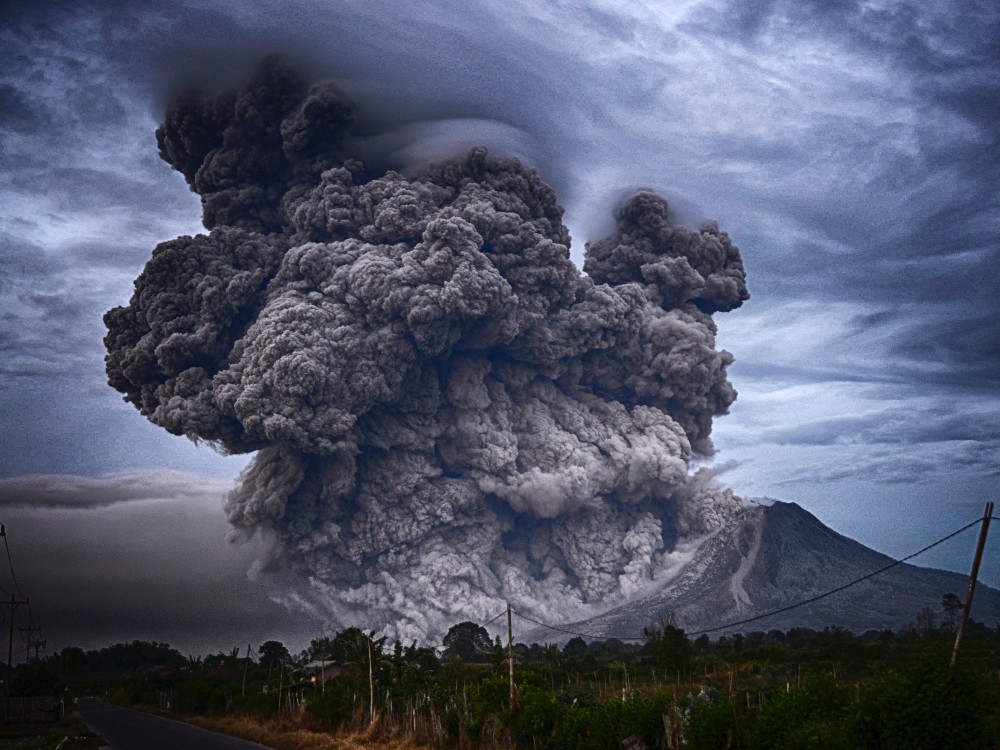 The eruption of Mount Sinabung in Indonesia. Image: Yosh Ginsu
The eruption of Mount Sinabung in Indonesia. Image: Yosh Ginsu
In addition to a compromised food chain, global temperatures can plummet due to the lack of sunlight. This happened most recently in 1816, when a significant eruption in Indonesia caused what became known as the "year without a summer," resulting in crop failures across the Northern hemisphere as a result of low temperatures.
By comparison, the eruption of a supervolcano could cause temperatures to plummet for years on end. Such an event could trigger another ice age, precipitated by a fall in global temperatures and the mass die-off of plants and animals that have adapted to specific environmental niches.
What makes large-scale volcanism particularly risky is that it could completely destroy the agricultural sector we rely on for sustenance, preventing us from producing enough food to feed the nearly 8 billion people on Earth. If sun-deprived conditions caused by atmospheric ash were to continue for several years, this would lead to mass starvation on an unprecedented level.
2. Asteroid Impact
In Plato's Timaeus, the ancient philosopher seems to identify cataclysmic asteroid impacts as a threat to human civilization.
Famously, 65 million years ago, a gigantic asteroid struck Earth and caused the dinosaurs to go extinct. Well, that may not be entirely accurate. Some evidence points to the idea that around the same time this 10-kilometer wide asteroid slammed into what is today the Yucatan Peninsula, mass volcanic eruptions were spewing lava and ash into the atmosphere in today's India. don’t take down the dinosaurs with just one big space rock—you need to set the world on fire at the same time.
That's an example of a convergence of cataclysms. It's thought that the impact event itself may have been so powerful that it actually intensified these volcanic eruptions on the other side of the planet, essentially sealing the fate of the giant lizards and ushering in the age of mammals.
Luckily, over the past few decades, we've gained a considerable amount of knowledge about asteroids and their movements through the solar system. With more advanced asteroid-hunting telescopes being deployed all the time, NASA has been on the forefront of detecting and cataloging near-Earth asteroids for quite some time.
We now know with a large degree of confidence the orbits and trajectories of perhaps 90-95% of all of the near-Earth asteroids larger than one kilometer in size—these are the planet-killing asteroids, large enough that a potential impact would cause destruction across an entire continent. There may be as many as 1,000 of these orbiting in our general vicinity.
From there, things get a bit more bleak. There are an estimated 27,000 near-Earth asteroids larger than 140 meters in size, of which we've only identified approximately one third. Asteroids this large are capable of wiping a small- to mid-sized country off of the map, and it's a little bit disconcerting that the majority of these are yet to be found and cataloged. While such an event would be unlikely to cause the downfall of global civilization, it could certainly cause global instability on a large scale—especially if it impacted a significantly populated area.
And then we have the significant leftovers—an estimated 840,000 near-Earth asteroids measuring between 40 to 140 meters in size, of which we've only identified around 1.5% so far. These objects would be larger than the Chelyabinsk meteor that exploded over Russia in 2013 and injured some 1,500 people, and closer in size to the meteor that caused the infamous Tunguska event in the middle of Siberia back in 1908.
An asteroid over 40 meters in diameter is referred to as a "city-killer," and could conceivably cause significant or even cataclysmic damage to an urban metropolis in the case of a direct hit. The danger here is that city-killers are smaller and more difficult to detect than larger asteroids, so they're much more likely to strike with little or no warning.
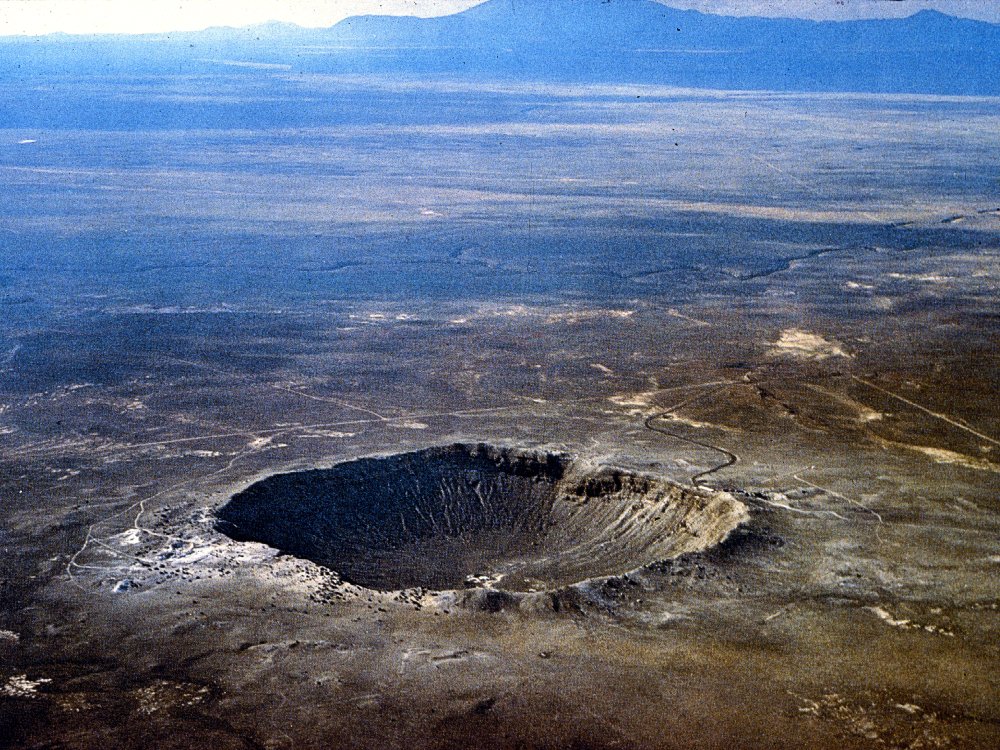 A 1.2 kilometer wide impact crater caused by a 50 meter asteroid some 50,000 years ago. This type of impact would completely destroy a city center and most of the surrounding structures. Image: Wikimedia Commons/USGS/D. Roddy
A 1.2 kilometer wide impact crater caused by a 50 meter asteroid some 50,000 years ago. This type of impact would completely destroy a city center and most of the surrounding structures. Image: Wikimedia Commons/USGS/D. Roddy
Fortunately, assuming an equal distribution of asteroid impacts across the Earth's surface, it's more likely that such an impact would end up in the middle of the ocean or a large empty expanse of land, like Siberia—so we probably don't need to worry that much. Even so, it could be wise to continue our investment in asteroid detection capabilities.
While we may not know with 100% accuracy when the next deadly asteroid might come our way, we can be 100% confident that one day it will—whether or not we're still around to witness it.
3. A Wandering Rogue Planet
If the prospect of a 10-kilometer wide asteroid slamming into Earth sounds daunting, imagine what a collision with a planet-sized object might do. This has happened before—about 4.5 billion years ago, culminating in the formation of the Earth and our Moon.
But this event occurred between two planetary bodies in unstable orbits within our early solar system, a condition which doesn't exist in today's modern solar system (it's extremely unlikely that Mars, for example, would collide with the Earth at any point in the future). But that doesn't entirely rule out collisions with planetary bodies originating from outside of our solar system.
While all planets must initially form in orbit around a star, they don't necessarily have to remain there. In some cases, planets can be ejected from their originating star system (ie. by being pushed out by the gravitational influence of another large planet or star), becoming doomed to roam interstellar space without being connected to a host star. At this point, they become known as rogue planets.
It's estimated that in our Milky Way Galaxy alone, rogue planets may outnumber the amount of stars in the galaxy. Higher estimates seem to indicate that rogue planets may outnumber stars by several orders of magnitude.
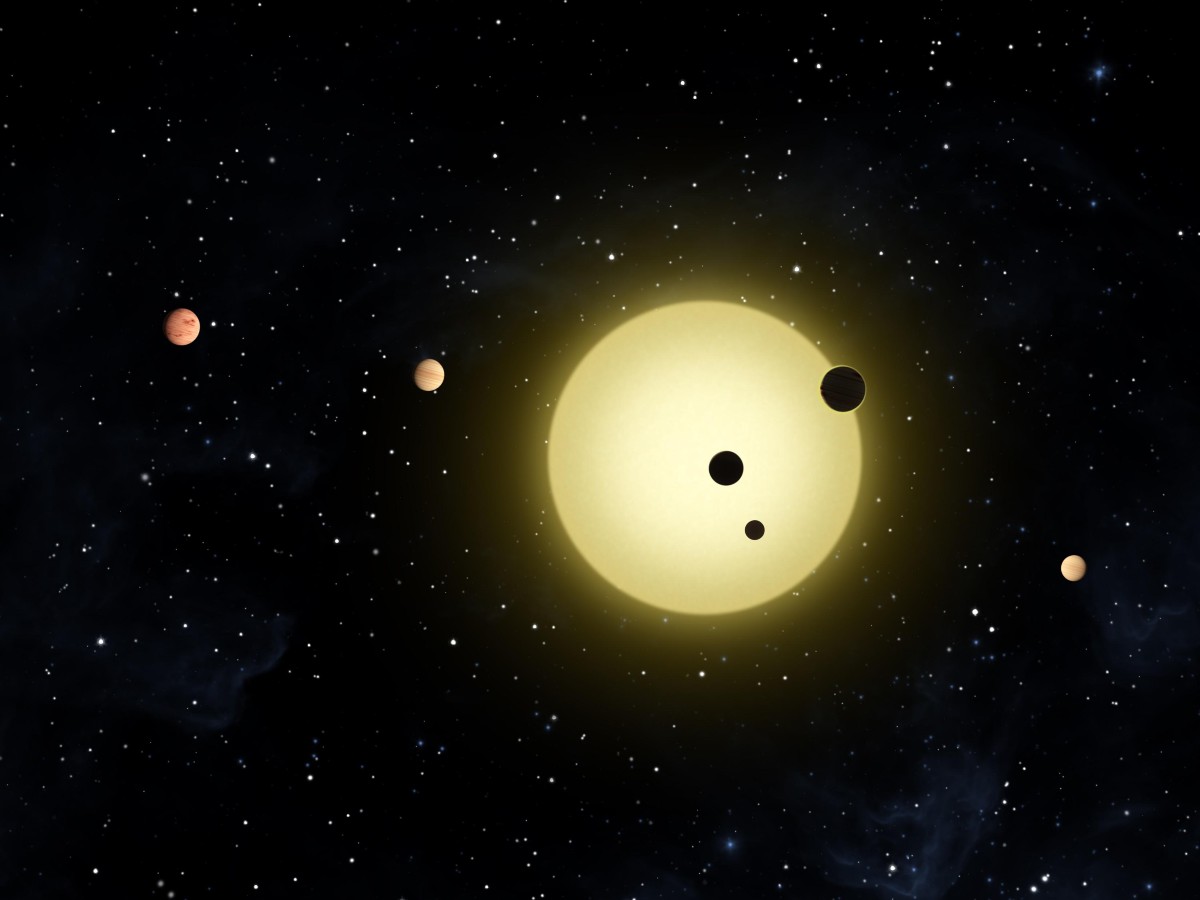 An artist's impression of exoplanets around a distant star. Image: Wikimedia Commons/NASA
An artist's impression of exoplanets around a distant star. Image: Wikimedia Commons/NASA
A rogue planet entering our solar system from interstellar space could cause significant disruption in the orbits of asteroids, comets, and our neighboring planets. These effects could be particularly worsened depending on the size of the rogue planet that comes to visit—we know from surveys of nearby star systems that exoplanets several times more massive than Jupiter appear to be common.
The instability caused by a close encounter with a wandering rogue planet could send massive comets from the Oort cloud raining down on the inner solar system, or even destabilize the orbits of other planets and cause them to be ejected from our solar system entirely (or send them colliding into another planet).
Since the vast majority of our solar system consists of empty space, it's extremely unlikely that such an object would collide with another planetary body or become trapped in orbit around our sun, but this is another possibility.
Worst of all, since a rogue planet wouldn't be emitting any visible light, detecting these objects in interstellar space would be extremely difficult. We likely wouldn't know that such an object was approaching until it was already knocking at our door.
4. A Close Encounter with a Star
Planetary objects aren’t as big as they get—we might also need to consider the possibility that neighboring stars could get a little too close for comfort.
We know that the Oort cloud may extend as far as several light years beyond our solar system. Any star entering within the Oort cloud could cause an incredible amount of disruption, resulting in a bombardment of icy comets and planetesimals raining down on us from the outer solar system.
Proxima Centauri, our Sun's nearest neighboring star, currently sits at a comfortable 4.2 light years away. At this distance, this relatively small star (being only around 1/8th the mass of our own sun) isn't large enough or close enough to cause any such perturbations of the Oort cloud. But there are plenty of other stars in our galactic neighborhood, and they have a habit of moving around.
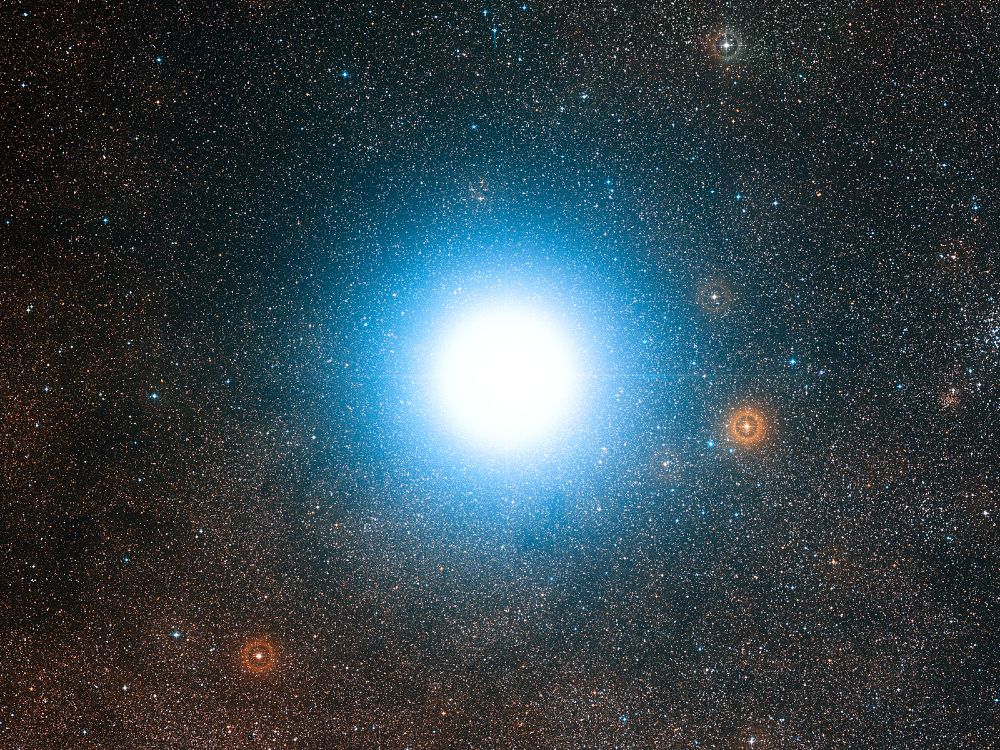 At 4.37 light years away, Alpha Centauri is the nearest star system to Earth after our own sun. Image: ESO/DSS 2
At 4.37 light years away, Alpha Centauri is the nearest star system to Earth after our own sun. Image: ESO/DSS 2
It's currently estimated that in about 1.3 million years, Gliese 710, a nearby star with 60% the mass of our Sun, may approach as close as 0.22 light years to Earth. The results of this encounter may be catastrophic for Earth and the inner solar system in general, causing massive comets to be hurtled into the inner solar system at a highly accelerated rate for several million years.
Assuming life on Earth still exists by then, the Sun's close encounter with Gliese 710 would significantly increase the probability and frequency of a significant impact event occurring—perhaps even an impact more devastating than what happened to the dinosaurs.
5. Black Holes in our Midst
Since the concept of black holes entered the scientific canon and the public lexicon several decades ago, humans have been captivated by the concept of a point in space from which nothing—not even light—can escape. In addition to their mystique, black holes may also represent a highly underrated existential threat to life on Earth.
This is for good reason. The mere existence of black holes had remained in the realm of scientific theory up until 2019, when the first-ever direct image of a black hole was captured.
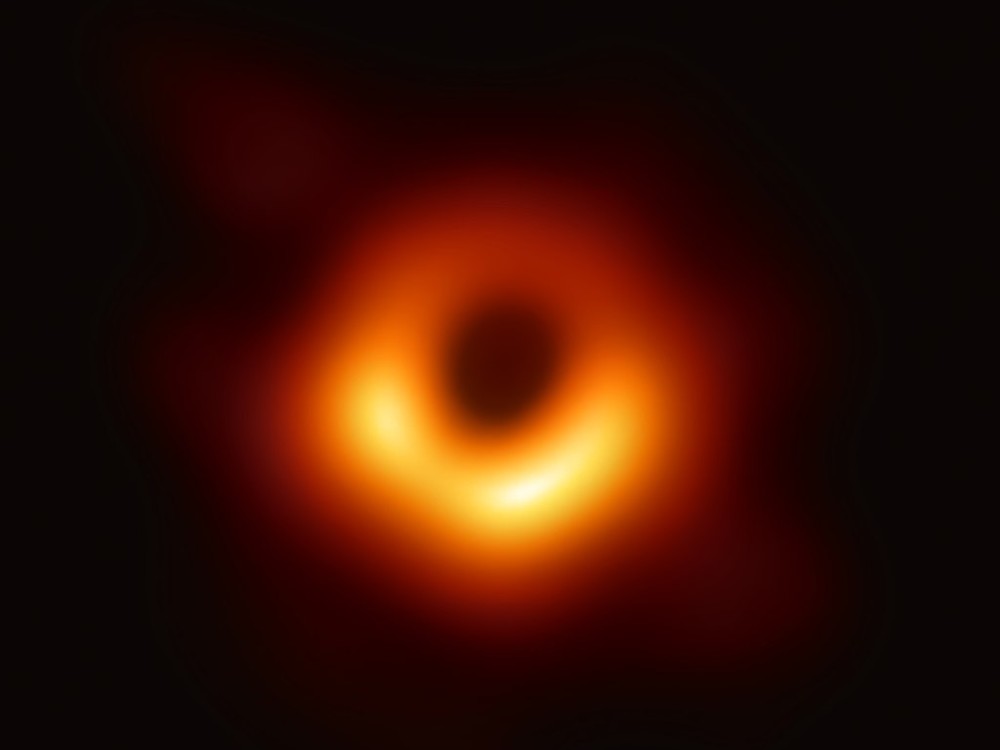 The first-ever image of a black hole was released in 2019 after tremendous effort. The M87 galaxy, with a supermassive black hole at its center, is located 53 million light years from Earth. Image: EHT Collaboration
The first-ever image of a black hole was released in 2019 after tremendous effort. The M87 galaxy, with a supermassive black hole at its center, is located 53 million light years from Earth. Image: EHT Collaboration
The recency of this image reveals the problem: because their gravitational fields are so strong that not even light can escape the event horizon, detecting a black hole against the backdrop of empty space is impossible. Because we can't detect them, we can't count them. And because we can't count them, we can never know for certain how many there are, and what the distribution curve is.
Nobody really knows how many black holes might exist in any given galaxy, or what the average size of these black holes might be. It's plausible that black holes ranging in size from a few dozen to a few hundred solar masses may be common, millions of which could be distributed throughout our galaxy without our knowledge. Detecting these objects from afar would be a nearly impossible feat, and it's conceivable that we wouldn't recognize their presence until we begun noticing the telltale signs of gravitational abnormalities in our galactic neighborhood.
The effects of a massive invisible object in our vicinity could be profound. Just as a rogue planet entering our solar system or a nearby star getting a little too close for comfort, a large black hole could push or tug at our solar system and nearby star systems from afar.
The large gravitational disruption that a black hole encounter would entail could send our sun hurtling towards the center of the galaxy, or could increase the probability of an unwanted encounter with a nearby star system.
6. A Nearby Supernova or Gamma Ray Burst
As if black holes and planetary collisions weren't worrying enough, we also need to contend with the fact that, at the end of their life cycle, some of the largest stars tend to explode and spew gamma radiations over long distances of space.
Gamma rays consist of extremely high-energy electromagnetic waves that can be hazardous to biological life. In some cases, gamma ray bursts produced by an exploding hypernova (a stellar explosion that's an order of magnitude more powerful than a supernova) can become narrowly focused into concentrated beams. If any of these gamma-ray beams were to be directed towards Earth, it could destroy the entire Ozone layer and leave our biosphere exposed to high-radiation cosmic rays.
 An image of the remnants of Supernova 1987A, some 168,000 light years from Earth. Image: ESO/L. Calçada
An image of the remnants of Supernova 1987A, some 168,000 light years from Earth. Image: ESO/L. Calçada
The beams from gamma ray-ray bursts can be so powerful that, when pointed in our direction, they've been detected at distances up to 10 billion light years away. At these distances, gamma-rays don't pose any threat to life on Earth. But if such an outburst were to originate from inside our Milky Way Galaxy, especially within a distance of a few thousand light years, that wouldn't be a good day for life on Earth.
Such an event is thought to be fairly uncommon, perhaps occurring every one billion years or so on average because hypernovae are relatively rare. But a hypernova isn't the only type of explosion that can produce high-powered gamma rays: we also have to consider the risk that a passing star could explode as a regular old supernova.
Because supernovae are far more common, these are far more likely to disrupt life on Earth than a distant gamma-ray burst. It's estimated that a sufficiently powerful supernova occurring within 50 light years of Earth may produce enough gamma radiation to destroy all or part of the Ozone layer. And the closer an explosion occurs, or the more x-rays and gamma rays it produces, the more devastating such an encounter could be.
One average, it's estimated that a supernova explosion occurs within 33 light years of Earth every 240 million years or so. Such an event may have been responsible for a mass-extinction event some 450 million years ago, in which up to 85% of marine species went extinct (during the Ordovician-Silurian extinction events).
If such an event were to occur today, there would be little we could do to mitigate the effects of sudden and total Ozone loss.
7. Fluctuations in our Sun's Energy Output
We don’t need to look outside of our solar system for killer stars—just look up in the sky on a sunny day (or don’t, because your retinas might burn out of your skull).
Forget about light-year distances; there's a gigantic nuclear fusion explosion in space going on just 8 light-minutes away from Earth, every second of every day, for the past 4.6 billion years. And most of the time, we aren't even worried.
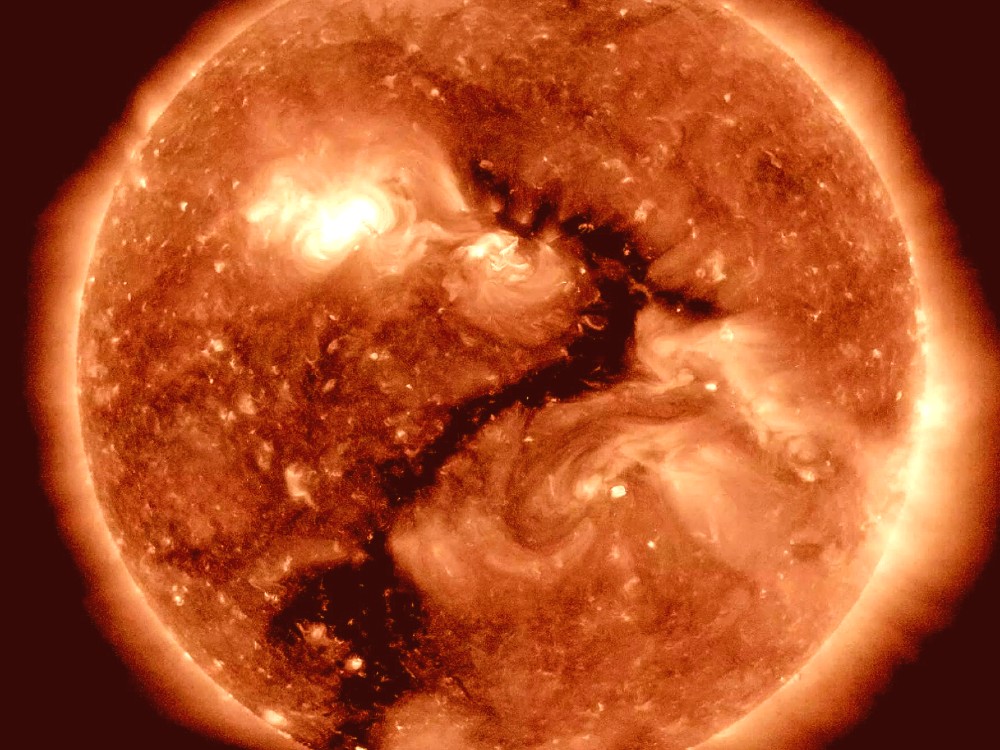 A closeup of the Sun captured by NASA's Solar Dynamics Observatory. Image: NASA/GSFC/Solar Dynamics Observatory
A closeup of the Sun captured by NASA's Solar Dynamics Observatory. Image: NASA/GSFC/Solar Dynamics Observatory
We know that the Sun is capable of producing solar storms and solar flares. While these aren't typically powerful enough to seriously disrupt life on Earth, there is reason to consider our own Sun as a potential driver of civilization collapse.
Back in 1859, a powerful geomagnetic storm had a direct impact on Earth. This is known as the Carrington Event, and it was powerful enough to bring down telegraph systems at the time. Had this type of event occurred today, it would have caused widespread blackouts and damage to the electrical grid. Since most of our civilization runs on electricity and relies on digital computers, any significant damage to these systems caused by a future solar storm could cause an unprecedented global disruption with cost estimates ranging in the trillions of dollars.
While we could take steps to make sure our electronics and electrical grids are robust enough to survive such an event, the Sun does have another trick up it's sleeve. Over time, the Sun's energy output tends to fluctuate—it can decrease over some ~11 year cycles, and increase over others. While these fluctuations are usually very small, they do have an impact on the Earth's climate: it's thought that the Sun's current cycle of increased energy output may be responsible for anywhere from 7% to upwards of 30% of global warming over the past 30 years (with the rest being attributed to human activity).
It's thought that the Sun's energy fluctuations over time may also be partly responsible for the numerous glacial periods (or ice ages), followed by warmer interglacial periods (the climate of the past 11,700 years) that have occurred in the Northern Hemisphere over the past 2.5 million years. Of course, due to the complexity of these systems and the numerous drivers of warming and cooling periods, scientists can't be completely sure to what extent different inputs (such as solar fluctuations) may account for climate fluctuations.
This puts human civilization in a precarious spot, faced with two extremes: unprecedented global warming, and the prospect of slipping into another ice age. Sometimes it doesn't take a direct impact or a supernova to cause a global catastrophe, but rather the slow progression of complex natural cycles that we don't yet fully understand.
8. The Sun's Red Giant Phase
While fluctuations in solar output play out over the short-term (hundreds or thousands of years), the long-term future of our Sun looks a lot different.
For one, the Sun's luminosity has increased by about 1% every 110 million years. Within a few hundred million years, the increasing energy output of the Sun may have may begin having a more extreme impact on Earth's climate, causing global temperatures to rise and making life on Earth more difficult overall.
This increased luminosity will continue until, in about 5 billion years (when the sun is 67% more luminous than today), all of its hydrogen fuel will be exhausted and it will begin transitioning into its red giant phase. Life on Earth won't last long enough to see this, as increasing solar output and global warming will likely cause all life on Earth to go extinct within 2.8 billion years.
If human civilization is still around a few hundred million years from now, the only option for our long-term survival would be either moving the Earth or moving ourselves to other planets altogether (ie. Mars) as solar output increases. That is, if we haven't packed up and left the solar system entirely by that point.
9. The Heat Death of the Universe
If human civilization does manage to colonize other stars and worlds in the galaxy, then there's a good chance we'll survive well past the Sun's red giant phase. But there are limits. And there's no escaping the slow and eventual death of the universe itself.
The laws of physics tells us that in any system, entropy always increases. In short, by natural processes, thermal energy always progresses towards achieving greater equilibrium and less structure.
For example, take a hot cup of coffee in an enclosed room with a set temperature. Added together, the room and the coffee have a set amount of energy (in the form of temperature), but it's unbalanced. The freshly brewed cup of hot coffee possesses more energy relative to the rest of the room.
Over time, the amount of thermal energy in the coffee will diminish. The excess heat will dissipate into the room, slightly warming it. Eventually, the cup of coffee and the rest of the room will achieve the same temperature and energy level—they will have achieved equilibrium. This is an example of entropy doing its thing.
And this same process is playing out across the entire universe.
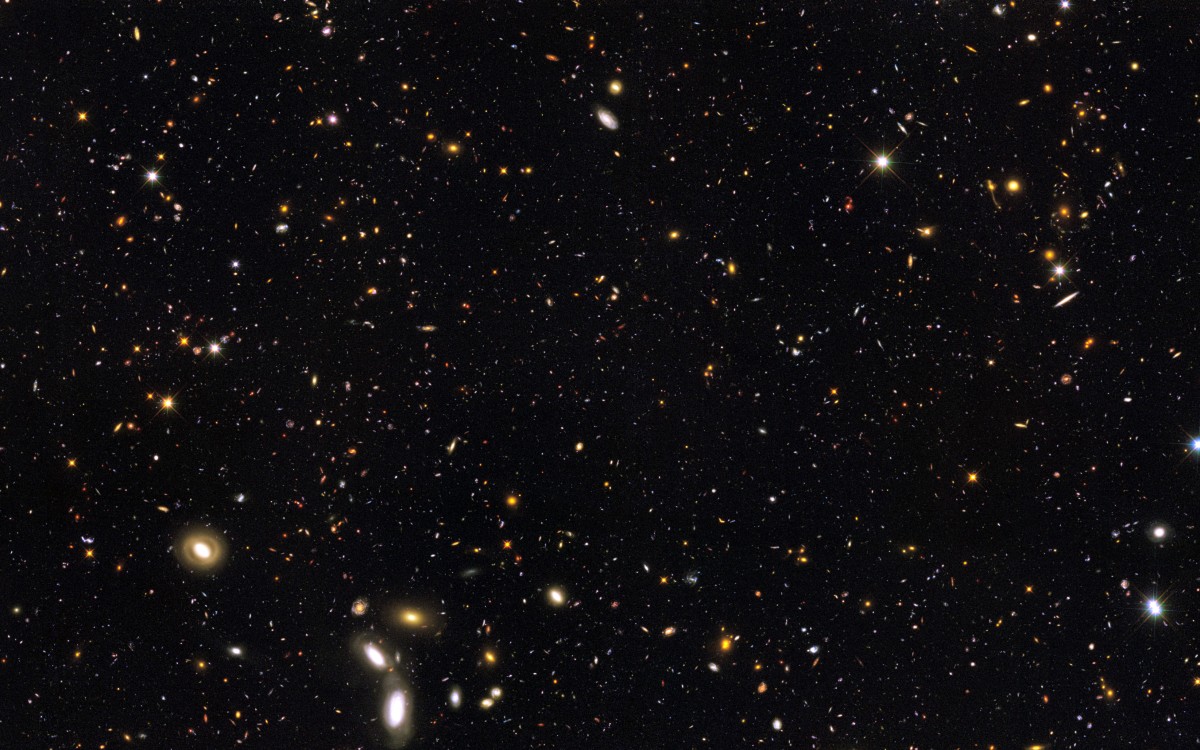 Thousands of distant galaxies captued by Hubble, some of which are more than 13 billion light years away. Image: NASA/ESA et al.
Thousands of distant galaxies captued by Hubble, some of which are more than 13 billion light years away. Image: NASA/ESA et al.
Trillions of years from now, all of the stars in the universe will have expended all of the available fuel for nuclear fusion to take place. Star formation will come to an end, the universe will go dark, and the temperature of all of the planets in the universe will gradually approach absolute zero.
Life as we know it relies primarily on solar energy to survive (all of the food you or I eat can only exist thanks to photosynthesis). Some lifeforms can survive on chemical energy produced through geological processes, but even this energy source is short-lived: as planets cool, geologic activity grinds to a halt.
Once all of the stars in the universe have gone dark, there won't be any more energy available for biological processes to continue. Life will cease to exist.
Assuming civilization is able to survive until then, the final heat death of the universe seems like a cruel joke. Even if we do manage to avoid human-induced global catastrophes and navigate through these potential cosmic cataclysms, it won't be enough to continue existing indefinitely. No matter what we do, our fate as living beings is ultimately sealed by the cosmos itself.
Cover image published under CC0 1.0.




